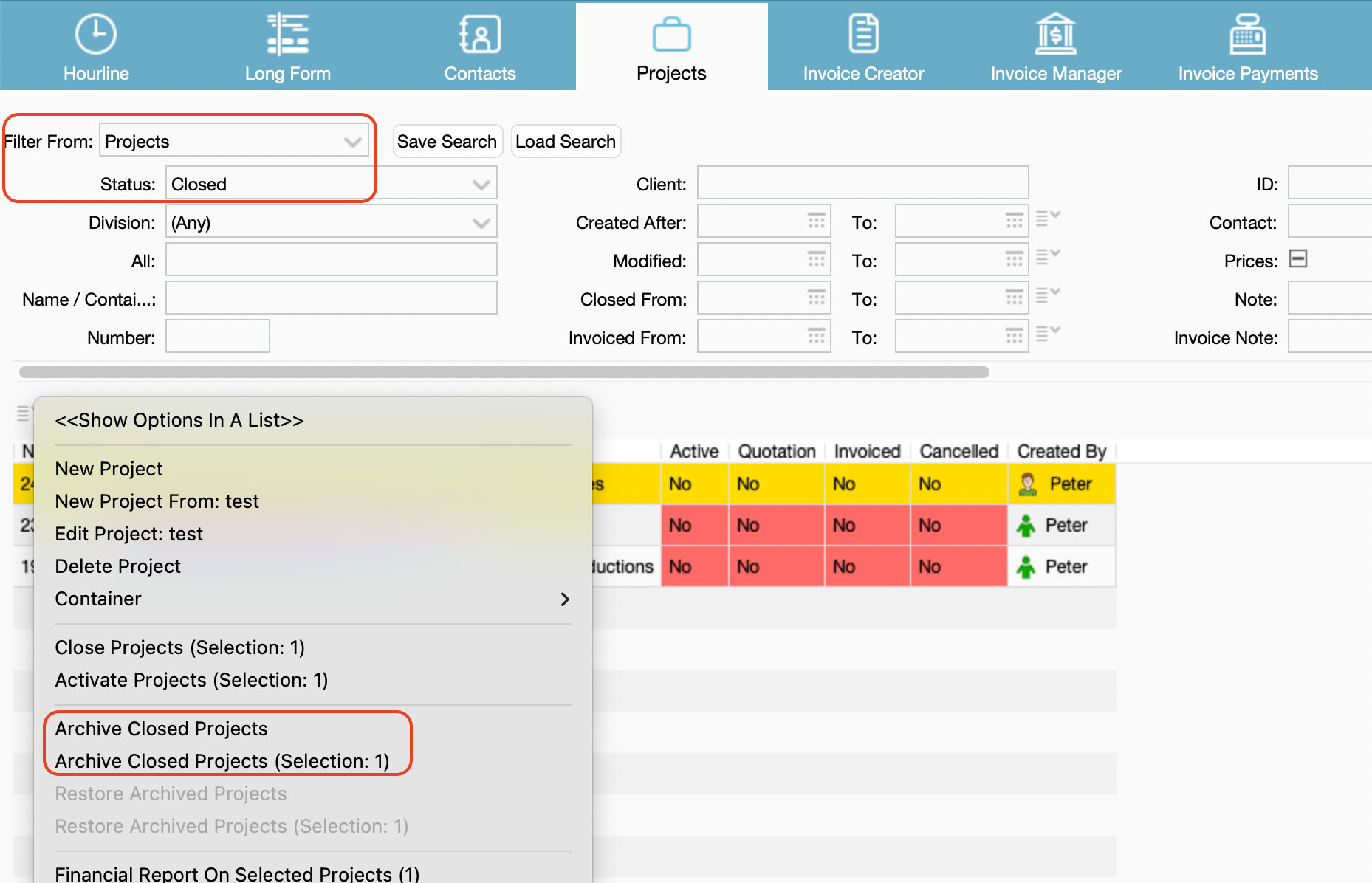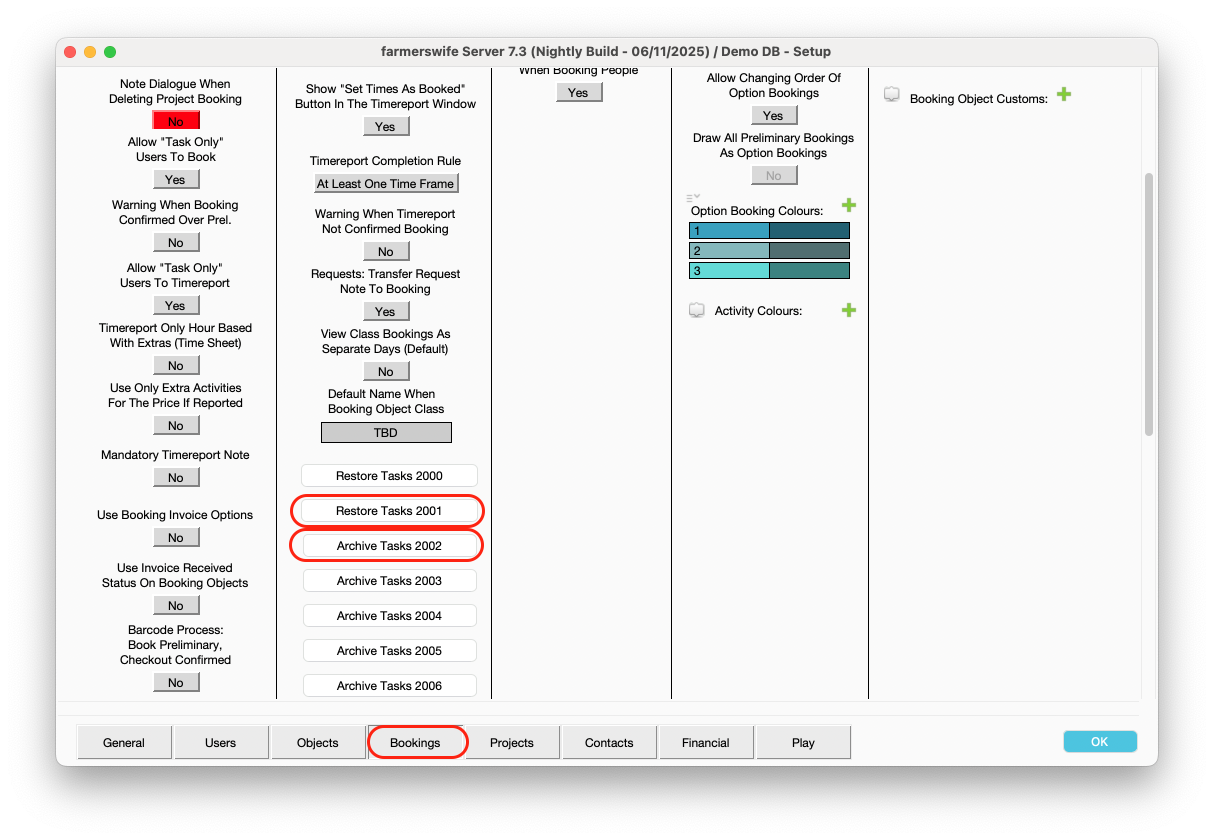As your farmerswife database grows, it’s good practice to give it a little care from time to time.
Here are a few quick actions you can take to reduce the database size and speed up the system!
Steps:
- Deleting Deleted Bookings and Binders
- Archiving Projects
- Archiving Tasks
- Archiving PO's & Incoming Invoices
- Archiving Media Orders
- Local hosted systems: Archived Files
Deleting Deleted Bookings and Binders
All deleted bookings and binders are stored in the “Deleted Bookings And Binders” tab in your Toolbox.
When this list grows large, it’s best to clear out old entries you no longer need.
Recommended cleanup:
Sort the list by Deleted Date, keep only the last 4–6 weeks, then select the older ones and choose Delete.
You can also use “Delete All” or “Delete All Bookings Belonging To Me (created by User)” from the right-click menu.
Note: User needs "Can Delete All Deleted Bookings" Permission to perform these actions.

Archiving Projects
Projects can be archived directly from the farmerswife Client application.
- Only Super Users (Tasks/Bookings/Rates) with access to "Server Setup" are able to archive within farmerswife.
- Only Closed and Invoiced Projects should be archived — this will include related bookings, extras, virtual bookings and work orders.
- Archived Projects will be listed under the Archived filter.
- Archived Bookings and Tasks are hidden from the timeline.
- Archived Projects/Bookings are excluded from Financial Reports.
- It is recommended to archive onlyold Projects from 2 oder more years into the past.
Archive from Toolbox
To archive:
Go to Toolbox > Projects tab.
Show all Closed Projects in the selector bar at the bottom.
- Select the ones to archive and choose Archive Closed Projects (Selection: X) from the dropdown menu.
Confirm the date range and proceed.

Archive Closed & Invoiced Projects
1. Select if you want to archive "Only Invoiced Projects""
- Yes: only invoiced Projects are to be archived;
- No: only Closed not Invoiced Projects will be archived.
2. Choose a date. This date refers to the Closed Time Stamp of the Project.
- Yes: a calendar shows for you to select a date up to which "closed" date you wish to archive the Projects.
- No: all closed projects show in the selector
3. A "Selector" window displays all projects according to the previous choices.
You can deselect a Project by dragging it from the right window in the left window. If you click on the little arrows in the center you will be able to move the entire Project list from one side to the other. This could be very useful if you have a very long list and you only want to select a few. You could then move them all to the 'Not Selected' list and choose the few that you want to move to the 'Selected' window.
Click OK, to archived the selected list of projects
The Status of the archived Projects is now Archived, and can be found when selecting that Status in the Toolbox.
A Project that has been closed and archived but not invoiced will not appear in the Invoice Creator. Once a Project that has been restored it will appear in the Invoice Creator again and can be invoiced from there and later archived again.
Archive from Project Search
You can also archive from the Advanced Project Search, filtering for Closed or Invoiced projects. Batch archiving is supported!
- Select to Filter From: Projects and "Search".

- Select (mark in yellow) the Closed or Invoiced Projects that you need to archive, and by clicking at the top left corner of the Search pane (also accessed by a right-mouse click), then Archive Closed Projects (Selection: X). Only those Projects will be archived.

3. Once the Project is archived you will find it under "Archived".
Tips for filtering which projects to archive:
- If you are closing and invoicing your projects you can search your closed projects as a first step.

- If you are not sure which projects can be closed you can easily identify some of your old projects with searching the projects "without bookings after date".

- You can also edit the view in the Advanced Project Search and filter your projects by their size. Click on the menu in the left corner and add "Project DB Size" to the view. This way you can see which of your projects are the biggest/ smallest and try to archive the biggest one in the first place.

- You can batch close and batch archive your projects!

Restoring Archived Projects
Go to Toolbox > Projects or Advanced Project Search, filter by Archived, and double-click the project.
Choose Restore From Archive > Yes when prompted. Once done, you can re-archive it after review.
If you get a message that the archive is missing and the Project cannot be restored please contact support@farmerswife.com
Select multiple Projects by holding Ctrl (PC) or Cmd (Mac) and clicking on the Projects that need to be restored. Go to the drop-down menu and select Restore Archived Projects (Selection:X).

Archiving Tasks
Task Bookings can be archived per year. They will be hidden from the timelines and can only be archived and restored from within the farmerswife Server application in the Server Setup under the Bookings tab.
Contact Support to assist is you're cloud hosted.

Archiving PO's & Incoming Invoices
You can also archive your Purchase Orders (POs) and Incoming Invoices (IIs). The related Projects or PO's (linked to Incoming Invoices) need to be archived beforehand.


Check related Toolbox Settings: Toolbox > Settings > Server Setup:
Archiving Rules: To decide what should be included when archiving Incoming Invoice or skipped
- Incoming Invoices:
Must Be Said As Paid
Must Be Set As Transferred

Archiving Media Orders
If you have the Media Orders option licensed please see the article about Archiving Media Orders.
Local hosted systems: Archived Files
Before you start with the archiving process, consider applying the following best-practice actions:
- Take a backup of the fw Server's installation folder. Remove the 'backups' folder from within the "system" folder to significantly reduce the backup-footprint. Copy the fw Server app's installer file to your backup, in case you need to run this DataSet again.
- Be aware that the archiving process removes data from the past. It is therefore also no longer available for Reporting purposes.
- For big and longer term Projects ensure each Project is max one year; consider using Containers for long-term Projects, where containied projects only span a year. Or, depending on the amount of contained events, to work with monthly Projects.
- Monitor the size of the 'current45.efdb' file located within the fw Server app's 'system' folder. Take a benchmark count of it's size before you begin each archiving session. Use the "Backup Now" button after each major archiving action, to flush the latest system-state down to file.
- farmerswife system only judged by the size of the 'current45.efdb' can be used as an indicator to archive old Data:
- "new / small": 1 MB to 50 MB - no need to archive anything
- "middle": 51 MB to 100 MB - no need to archive anything
- "Big": 101 MB to 200 MB - archiving to start now
- "Very Big": 201 MB to 300 MB - latest now start implementing archiving, get in touch with fw support if you require assistance
- "Huge": 300+ MB - please get in touch with us, to assist on analysing your system and assist on archiving.
Archiving in farmerswife can be used for Closed and/or Invoiced Projects, completed Tasks and Done Media Orders and Purchase Orders and Incoming Invoices and Labour Rules Closing Points.
The archived information is extracted from farmerswife proprietary database 'current45.efdb' and stored in separate files within the 'archives' folder located within the 'system' folder of the fw Server app.
The 'archives' folder will now contain an 'id'-file for each archived Project, Media Order and Task (per year), etc..

By doing so, the size of the database is reduced, and unused data from the past is removed from the 'current45.efdb' file, thus improving performance of the whole system.

Was this article helpful?
That’s Great!
Thank you for your feedback
Sorry! We couldn't be helpful
Thank you for your feedback
Feedback sent
We appreciate your effort and will try to fix the article
